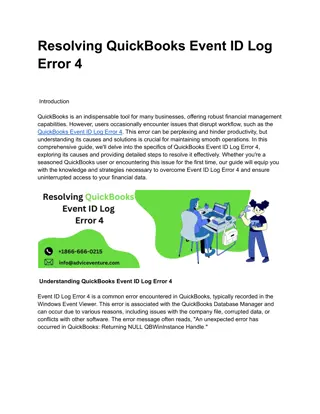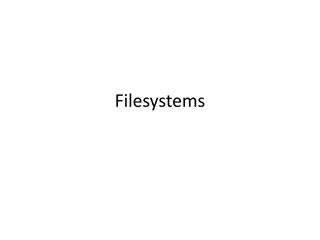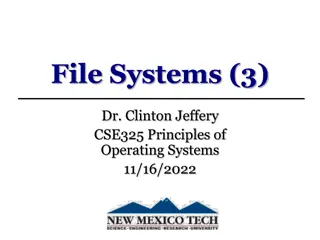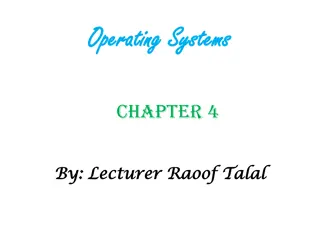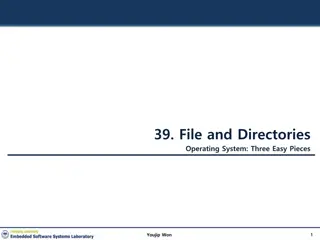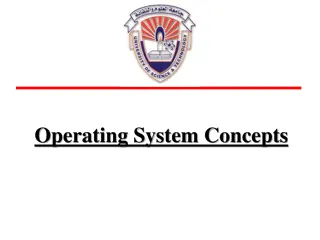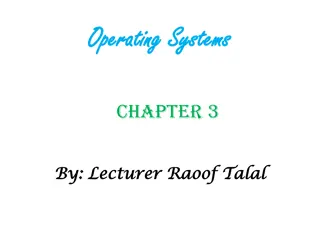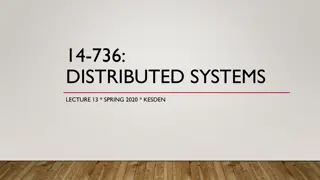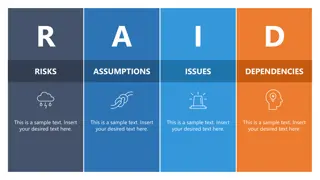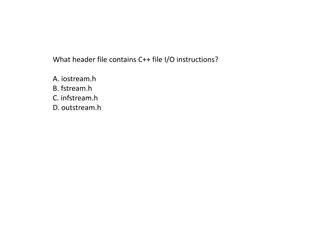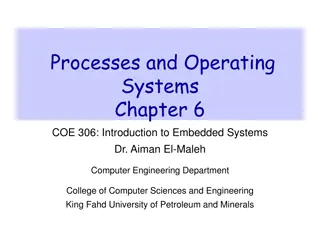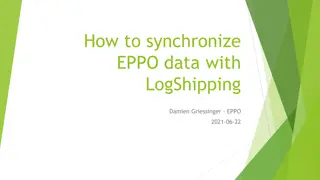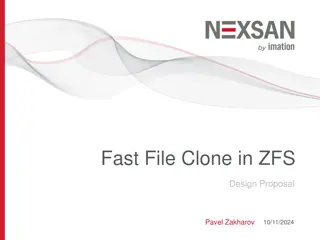Understanding Log-structured File Systems in Operating Systems
Log-structured file systems (LFS) address performance issues by transforming updates into sequential writes to disk. This process improves efficiency by buffering updates in memory before writing them to disk. The strategy includes determining buffer size to optimize write effectiveness and utilizing inode maps to locate scattered inodes within the disk space.
Download Presentation

Please find below an Image/Link to download the presentation.
The content on the website is provided AS IS for your information and personal use only. It may not be sold, licensed, or shared on other websites without obtaining consent from the author. Download presentation by click this link. If you encounter any issues during the download, it is possible that the publisher has removed the file from their server.
E N D
Presentation Transcript
43. Log-structured File Systems Operating System: Three Easy Pieces 1 Youjip Won
LFS: Log-structured File System Memory sizes were growing. Large gap between random IO and sequential IO performance. Existing File System perform poorly on common workloads. File System were not RAID-aware. 2 Youjip Won
Writing to Disk Sequentially How do we transform all updates to file-system state into a series of sequntial writes to disk? data update D A0 metadata needs to be updated too. (Ex. inode) blk[0]:A0 D I A0 3 Youjip Won
Writing to Disk Sequentially and Effectively Writing single blocks sequentially does not guarantee efficient writes After writing into A0, next write to A1 will be delayed by disk rotation Write buffering for effectiveness Keeps track of updates in memory buffer (also called segment) Writes them to disk all at once, when it has sufficient number of updates. blk[0]:A0 blk[0]:A1 blk[0]:A2 blk[0]:A3 blk[0]:A5 D[j,0] D[j,1] D[j,2] D[j,3] D[k,0] A0 A1 A2 A3 inode[j] A5 inode[k] 4 Youjip Won
How Much to Buffer? Each write to disk has fixed overhead of positioning Time to write out D MB ? (43.1) ??????= ?????????+ ????? (?????????: positioning time, ?????: disk transfer rate) To amortize the cost, how much should LFS buffer before writing? Effective rate of writing can be denoted as follows ? ? (43.2) ??????????= ??????= ? ????? ?????????+ 5 Youjip Won
How Much to Buffer? Assume that ??????????= ? ?????(F: fraction of peak rate, 0 < F < 1), then ? = ? ?????(43.3) ??????????= ? ????? ?????????+ Solve for D ? 1 ? ????? ?????????(43.6) D = If we want F to be 0.9 when ?????????= 10???? and ?????= 100??/?, then ? = 9?? by the equation. Segment size should be 9MB at least. 6 Youjip Won
Finding Inode in LFS Inodes are scattered throughout the disk! Solution is through indirection Inode Map (imap) LFS place the chunks of the inode map right next to where it is writing all of the other new new information blk[0]:A0 map[k]:A1 D I[k] imap A0 A1 7 Youjip Won
The Checkpoint Region How to find the inode map, spread across the disk? The LFS File system have fixed location on disk to begin a file lookup Checkpoint Region contains pointers to the latest of the inode map Only updated periodically (ex. Every 30 seconds) performance is not ill-affected blk[0]:A0 map[k]:A1 imap [k..k+N]: A2 D I[k] imap CR A0 A1 A2 0 8 Youjip Won
Reading a File from Disk: A Recap Read checkpoint region Read entire inode map and cache it in memory Read the most recent inode Read a block from file by using direct or indirect or doubly-indirect pointers 9 Youjip Won
What About Directories? Directory structure of LFS is basically identical to classic UNIX file systems. Directory is a file which data blocks consist of directory information blk[0]:A2 map[k]:A1 map[dir]:A3 (foo,k) blk[0]:A0 D[k] I[k] D[dir] I[dir] imap A0 A1 A2 A3 10 Youjip Won
Garbage Collection LFS keeps writing newer version of file to new locations. Thus, LFS leaves the older versions of file structures all over the disk, call as garbage. 11 Youjip Won
Examples: Garbage For a file with a singe data block Overwrite the data block: both old data block and inode become garbage blk[0]:A4 blk[0]:A0 D0 I[k] D0 I[k] A0 (both garbage) A4 Append a block to that original file k: old inode becomes garbage blk[0]:A0 blk[1]:A4 blk[0]:A0 D0 I[k] D1 I[k] A0 (garbage) A4 12 Youjip Won
Handling older versions of inodes and data blocks One possibility: Versioning file system keep the older versions around Users can restore old file versions LFS approach: Garbage Collection Keep only the latest live version and periodically clean old dead versions Segment-by-segment basis Block-by-block basis cleaner eventually make free holes in random location Writes can not be sequential anymore 13 Youjip Won
Determining Block Liveness Segment summary block (SS) Located in each segment Inode number and offset for each data block are recorded Determining Liveness The block is live if the latest inode indicates the block blk[0]:A0 map[k]:A1 A0: (K,0) SS D I[k] imap A0 A1 Version number can be used for efficient liveness determining 14 Youjip Won
Which Blocks to Clean, and When? When to clean Periodically During idle time When the disk is full Which blocks to clean Segregate hot/cold segments Hot segment: frequently over-written more blocks are getting over-written if we wait a long time before cleaning Cold segment: relatively stable May have a few dead blocks, but the other blocks are stable Clean cold segment sooner and hot segment later 15 Youjip Won
Crash Recovery and the Log Log organization in LFS CR points to a head and tail segment Each segment points to next segment LFS can easily recover by simply reading latest valid CR The latest consistent snapshot may be quite old To ensuring atomicity of CR update Keep two CRs CR update protocol: timestamp CR timestamp Roll forward Start from end of the log (pointed by the lastest CR) Read next segments and adopt any valid updates to the file system 16 Youjip Won
Disclaimer: This lecture slide set was initially developed for Operating System course in Computer Science Dept. at Hanyang University. This lecture slide set is for OSTEP book written by Remzi and Andrea at University of Wisconsin. 17 Youjip Won




